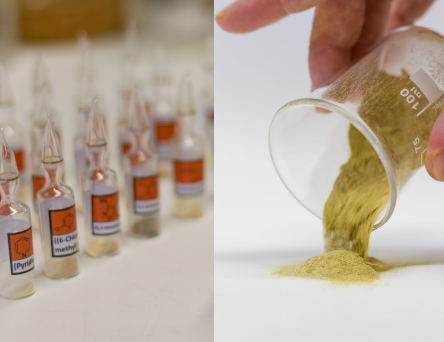Cobalt-Catalyzed Cross-Coupling Reactions of Bench-Stable Zinc Reagents
 Solid and bench-stable organozinc reagents (Picture: Peter Dowling)
Solid and bench-stable organozinc reagents (Picture: Peter Dowling)
LMU chemists, including the graduate student Jeffrey Hammann and the master student Ferdinand Lutter, led by Professor Paul Knochel have now developed a robust and broadly applicable cobalt-catalyzed cross-coupling of solid and bench-stable organozinc reagents. “Cobalt-catalyzed couplings are of special interest since cobalt salts are much less toxic than palladium salts and additionally are ca. 800 times cheaper,” notes Professor Knochel. “These coupling reactions can also be performed in technical (undistilled) THF with similar efficiency.”
Cross-couplings between heterocyclic moieties are also a synthetic challenge in industrial research. When palladium or nickel catalysts are used, catalyst deactivation is often observed owing to chelation of the reagents with the catalyst. “This method can also easily link heterocyclic moieties. The spectrum of coupling partners undergoing these couplings is very broad,” says Professor Knochel. “Basically, these coupling reactions can be performed with almost all types of unsaturated organic halides bearing various sensitive functional groups." These results appeared in the leading journal Angewandte Chemie International, and open the way to the use for a whole series of applications relevant to the pharmaceutical and agrochemical industry replacing palladium- or nickel-catalysts by inexpensive and less toxic cobalt-catalysts.
Publication: Angewandte Chemie